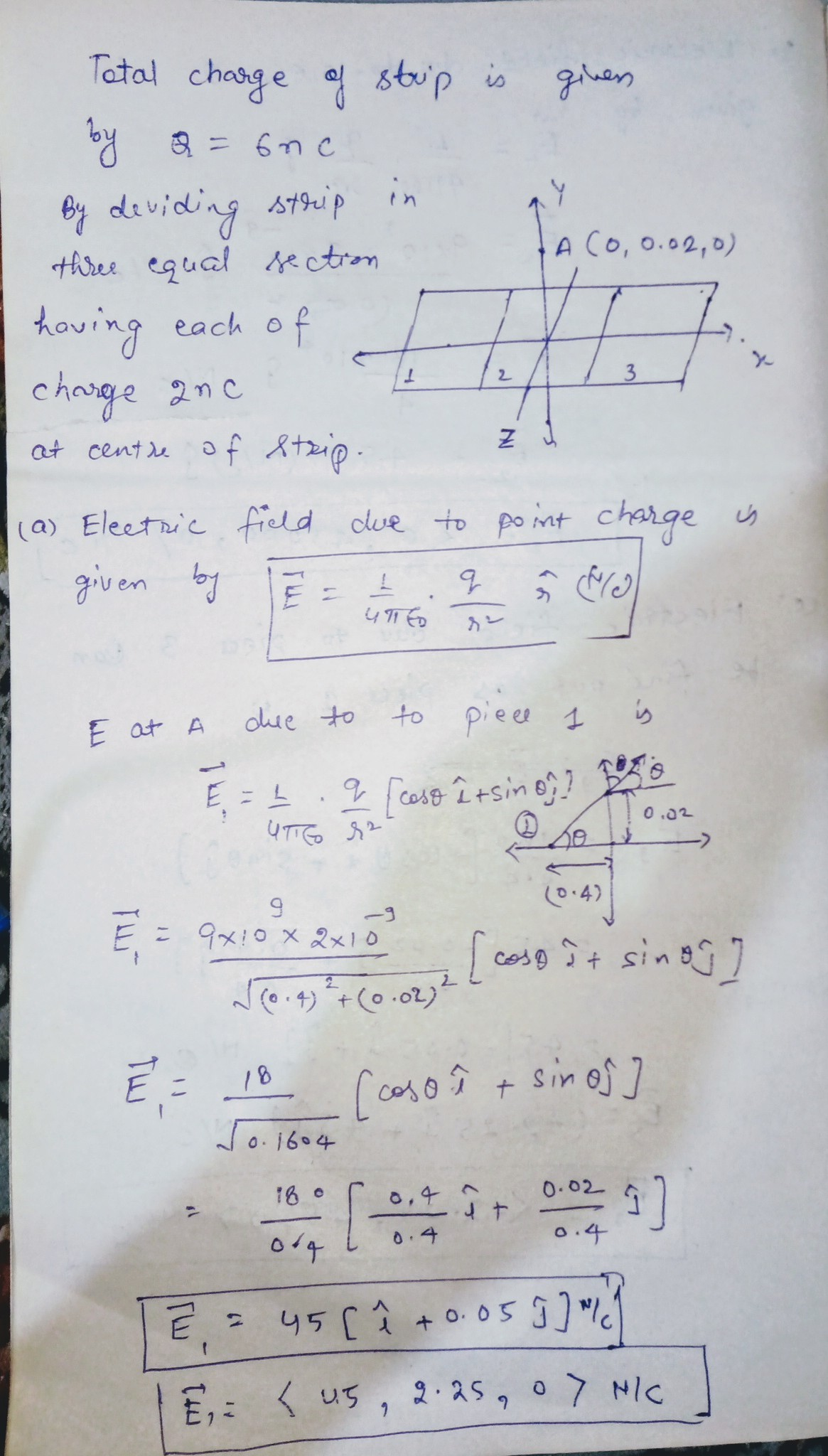suspended horizontally, so it lies along the x axis, with its center at the origin, as shown in the figure below. Calculate the approximate electric field at location <0, 0.03, 0> m (location A) due to the strip of tape. Do this by dividing the strip into three equal sections, as shown in the figure below, and approximating each section as a point charge. (Assume each point charge is located at the center of the section it approximates. Express your answer in vector form.) 2 E₁ = i A (a) What is the approximate electric field at A due to piece 1? i (b) What is the approximate electric field at A due to piece 2? i > N/C
suspended horizontally, so it lies along the x axis, with its center at the origin, as shown in the figure below. Calculate the approximate electric field at location <0, 0.03, 0> m (location A) due to the strip of tape. Do this by dividing the strip into three equal sections, as shown in the figure below, and approximating each section as a point charge. (Assume each point charge is located at the center of the section it approximates. Express your answer in vector form.) 2 E₁ = i A (a) What is the approximate electric field at A due to piece 1? i (b) What is the approximate electric field at A due to piece 2? i > N/C
College Physics
11th Edition
ISBN:9781305952300
Author:Raymond A. Serway, Chris Vuille
Publisher:Raymond A. Serway, Chris Vuille
Chapter1: Units, Trigonometry. And Vectors
Section: Chapter Questions
Problem 1CQ: Estimate the order of magnitude of the length, in meters, of each of the following; (a) a mouse, (b)...
Related questions
Question
show detailed work

Transcribed Image Text:A strip of invisible tape 0.12 m long by 0.011 m wide is charged uniformly with a total net charge of 4 nC (nano = 1×10-⁹) and is
suspended horizontally, so it lies along the x axis, with its center at the origin, as shown in the figure below. Calculate the approximate
electric field at location <0, 0.03, 0> m (location A) due to the strip of tape. Do this by dividing the strip into three equal sections, as
shown in the figure below, and approximating each section as a point charge. (Assume each point charge is located at the center of the
section it approximates. Express your answer in vector form.)
(a) What is the approximate electric field at A due to piece 1?
Ē₁
A
E₂ = < i
(b) What is the approximate electric field at A due to piece 2?
E3 = < i
i
(c) What is the approximate electric field at A due to piece 3?
i
"
i
(d) What is the approximate net electric field at A?
E net = i
i
(e) What could you do to improve the accuracy of your calculation?
i
i
i
i
> N/C
> N/C
> N/C
> N/C
O Use just two sections: due to symmetry about the y-axis, the components of the field due to each charge will be half of
the total electric field.
O Use more sections: as the number of segments approaches infinity, the summation of the electric fields approximates
the actual electric field.
O Use a smaller charge for piece 2 than for pieces 1 and 3: the actual electric field is similar to the field of a dipole, with
most of the charge on the tape at the left and right ends.
O Use a larger charge for piece 2 than for pieces 1 and 3: since location A is closest to piece 2, this piece has the most
significant contribution.
Expert Solution
Step 1

Step by step
Solved in 3 steps with 3 images

Knowledge Booster
Learn more about
Need a deep-dive on the concept behind this application? Look no further. Learn more about this topic, physics and related others by exploring similar questions and additional content below.Recommended textbooks for you

College Physics
Physics
ISBN:
9781305952300
Author:
Raymond A. Serway, Chris Vuille
Publisher:
Cengage Learning

University Physics (14th Edition)
Physics
ISBN:
9780133969290
Author:
Hugh D. Young, Roger A. Freedman
Publisher:
PEARSON

Introduction To Quantum Mechanics
Physics
ISBN:
9781107189638
Author:
Griffiths, David J., Schroeter, Darrell F.
Publisher:
Cambridge University Press

College Physics
Physics
ISBN:
9781305952300
Author:
Raymond A. Serway, Chris Vuille
Publisher:
Cengage Learning

University Physics (14th Edition)
Physics
ISBN:
9780133969290
Author:
Hugh D. Young, Roger A. Freedman
Publisher:
PEARSON

Introduction To Quantum Mechanics
Physics
ISBN:
9781107189638
Author:
Griffiths, David J., Schroeter, Darrell F.
Publisher:
Cambridge University Press

Physics for Scientists and Engineers
Physics
ISBN:
9781337553278
Author:
Raymond A. Serway, John W. Jewett
Publisher:
Cengage Learning

Lecture- Tutorials for Introductory Astronomy
Physics
ISBN:
9780321820464
Author:
Edward E. Prather, Tim P. Slater, Jeff P. Adams, Gina Brissenden
Publisher:
Addison-Wesley

College Physics: A Strategic Approach (4th Editio…
Physics
ISBN:
9780134609034
Author:
Randall D. Knight (Professor Emeritus), Brian Jones, Stuart Field
Publisher:
PEARSON